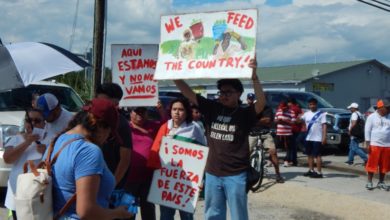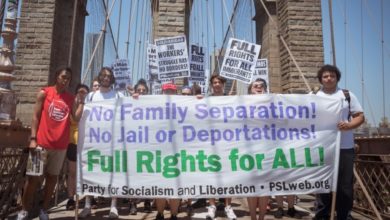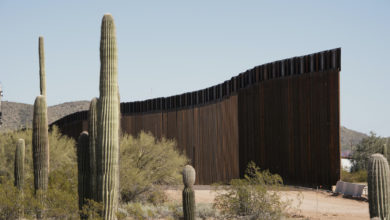
The U.S. government has unleashed a wave of terror against the huge immigrant community of California and the U.S. Southwest. Juan Jose Gutierrez of the Latino Movement USA estimates that 7,000 people have been rounded up in this new attack.
Federal agents have been stopping and arresting people at bus stops, on the street, while driving, and even while waiting in line at Mexican Consulates and federal agencies.
On July 1, Honduran immigrant Ecar Paz was beaten by Temecula Border Patrol agents, and later died in the Border Patrol station. While cops claimed that Paz died of a “self-induced suicide,” activists put the blame for his death on the Border Patrol.
These assaults are not aimed at eliminating immigration. The goal of the recent attacks is to terrorize the most oppressed sector of the working class into political submission and economic poverty. This, in turn, makes it harder for all workers to struggle for better wages and improved working conditions.
Expanding raids
In the past, anti-immigrant raids have taken place near the U.S.-Mexico border. This time, the raids occurred in several Los Angeles counties, Texas and other Southwest locations. This marks a significant policy shift for the Border Patrol and the U.S. Customs and Border Protection Agency, formerly known as the INS. The policy is expected to continue indefinitely.
The CBP, an arm of Bush’s Department of Homeland Security since March 2003, is a department ostensibly formed to fight “terrorism.” Mario Villareal, a CBP spokesman, told the June 10 Los Angeles Times that “interior checkpoints are a critical enforcement tool.”
The Times further quotes an official stating that the decision on who to stop is made on the basis of “nationality.” This unavoidably targets all people of color, particularly Latinos and Asians in California. The Times, the Modesto Bee and NBC all reported several incidents where people witnessed or were object of sweeps in areas where the CBP denies being active.
This is the latest assault on immigrant rights after the repeal of laws that allowed undocumented immigrants the right to receive drivers’ licenses—a repeal supported by Democratic presidential candidate John Kerry.
The result has been widespread fear in immigrant communities. Some people are so scared that they are not going to work and do not allow their children to go to school for fear of being stopped.
The Bush administration, taking advantage of the fear generated after September 11, has built an apparatus for the suppression of internal dissent, including the Department of Homeland Security. The federal government has allocated millions of dollars for spying on civilians within the U.S., including launching unmanned drones to fly over and spy on immigrant communities near the U.S.-Mexico border. The number of arrests of undocumented workers crossing the border jumped by almost a third in the last eight months, according to a July 5 Reuters report.
Even documented immigrants are under assault. The U.S. Citizenship and Immigration Services Department dramatically lowered the maximum number of H1B visas from 195,000 to 65,000. These visas are awarded to skilled workers who enter the country for a limited period of time.
The Department of Homeland Security has even refused to produce thousands of green cards for immigrants who have been awarded legal status by the courts in an effort to keep them from finding work and housing. These documented residents have filed a class action lawsuit against both DHS head Tom Ridge and Attorney General John Ashcroft.
The assault on immigrants in the interior of the West Coast, part of the Bush administration’s national anti-immigrant policy, is the logical continuation of Clinton’s “Illegal Immigration Reform and Immigrant Responsibility Act of 1996” and the infamous Proposition 187 in California. Clinton’s act was the first step at centralizing anti-immigration police authority at a federal level. It established an identification system to track immigrants. Proposition 187 aimed to keep undocumented immigrants from receiving health coverage, education and other public services.
Why the new assault on immigrants?

According to a Service Employees union fact sheet, 11.4 percent of all U.S. workers and 16 percent of all service workers are foreign born. They pay an estimated $133 billion in taxes. According to a 2001 UCLA School of Public Policy and Social Research study, undocumented workers from Mexico alone contribute $154 billion to the Gross Domestic Product of the U.S. Clearly, the ruling class doesn’t want to eliminate all immigration — bosses profit greatly off undocumented labor in the U.S.
The U.S. government is also well aware that by completely halting immigration, the economies of many U.S. client regimes in Latin America would plummet into chaos. For example, a July 9 El Diario/La Prensa report estimates that El Salvador’s primary source of income is the money that immigrants send back to their families. By the end of this year, it states, the amount of money that will go to El Salvador from Salvadoran workers in the U.S. is $2.5 billion. El Salvador’s exports in all of 2003 amounted to $3.136 billion.
According to the U.S. Citizenship and Immigration Services agency, undocumented immigration into the U.S. has grown by 350,000 each year from 1990 to 1999. Immigration from Mexico, the largest population of undocumented immigrants, grew from 2 million in 1990 to almost 5 million in 2000.
The growth in immigration to the U.S. from Mexico has coincided with the implementation of the North American Free Trade Agreement. According to the UCLA study mentioned above, NAFTA and the restrictive U.S. immigration policies have “facilitated the exploitation of cheap undocumented labor in the United States.”
Exporting capital, importing labor
One way for capitalist enterprises to be competitive and increase profits is by going to countries where production is less expensive in terms of materials and labor-exporting capital. The corporations do this by setting up shop wherever they are guaranteed lax environmental and labor regulations and where there are pools of poor people desperate to work for minimal pay. This has been increasingly possible due to agreements like NAFTA and its newly signed Central American counterpart, CAFTA, which make it easier for corporations to move about freely from country to country.
When capitalists export their capital abroad, they bring in new technologies and modern modes of production. The higher the technology, the more production is automated. Highly paid, skilled workers are then replaced by systems that can be operated by low paid unskilled labor. So the capital “investment” is not a panacea of jobs and progress for the poor host country but simply a source of cheaper and cheaper labor.
The export of capital and the migration of workers across national borders are integral elements of capitalism in its imperialist stage.
Karl Marx wrote, “The more the division of labor and the application of machinery expands, the more competition among the workers expands and the more their wages contract.” In oppressed nations, the result is that people leave their rural communities looking to find work in these new enterprises in the outskirts of the cities only to find themselves in shantytowns at the edge of starvation. When the new enterprise cannot employ them, then they logically go to the source of the capital: the imperialist center.
It is a fundamental feature of capitalism that workers migrate to the greatest concentrations of capital. That was the cause, for example, of the great migration of Black people from the rural South to the industrial North in the 1930s.
Many immigrants risk their lives under treacherous conditions to come here. They often have little alternative but to leave their children and spouses behind.
For this reason, the assaults in recent months in the Southwest do not aim to stop immigration outright, or even to curtail it. The goal is to terrorize this super-exploited sector of the working class. They are terror tactics to keep immigrants from organizing for better wages and fair treatment, and so to drive down the wages of all workers.
The recent attacks are also aimed at keeping these workers from building closer and open ties with other U.S. workers. Anti-immigrant attacks, like all forms of racism, play an important role in dividing the working class. The ruling class tries to pit the citizens against the immigrant workers so they will not join hands and work together with their class brothers and sisters.
Immigrants, labor fight back
Will the new attacks succeed in dividing working people? There are optimistic signs that this effort can be defeated by conscious struggle and solidarity.
The recent increase in harassment in the Southwest has bred a new wave of resistance. Workers and students have turned out for rallies, marches and pickets in downtown Los Angeles, San Francisco, San Diego and all across Southern California. Community activists and coalitions like Latino Movement USA, the Hermandad Mexicana Nacional, La Raza, the Alliance of South Asians Taking Action and many others have organized actions in support of immigrants. Significantly, the labor movement is playing a big role in fighting the recent attacks.
The United Farm Workers, joined by the SEIU and others, sponsored a five-day march through the Salinas Valley in California where hundreds of workers and supporters marched to demand an end to the raids and for permanent legal status. Seventy-two-year-old strawberry picker Damien Hernandez told the LA Times on July 2, “This march is about justice.”
In October 2003, thousands of immigrant workers traveled across the country for the Immigrant Workers Freedom Ride Caravans. The Freedom Ride ended in a huge rally of over 100,000 in Queens, New York City. This event, the first of its kind, was inspired by the Freedom Rides of the 1960s. It brought together families, community activists, students, seniors, Black, Latino, Arab, Asian and white workers in support of immigrant rights. Significantly, it was sponsored by the Hotel and Restaurant Employees, along with SEIU; SEIU Local 1199, New York City’s largest union of healthcare workers; the Needletrades and Textiles Employees union UNITE; and many other unions.
This event alone showed that immigrants are increasingly organizing, in the streets challenging the attempts to terrorize them into submission. Organized labor in the U.S. is also playing an increasing role in building unity and fighting for justice for all workers.
With the erosion of highly skilled jobs and the flight of capital across borders, the working class grows larger and more multinational every day. Immigrant workers bring with them valuable lessons of class struggle, both in the U.S. and from their native countries. These lessons will continue to enrich the labor movement, bringing greater militancy, solidarity and ultimately class consciousness in the struggles ahead.
Haitians demonstrate in front of the INS in San Francisco against racist deportations.
Photo: Bill Hackwell
Mass march against anti-immigrant Proposition 187 in Los Angeles, 1994.
Photo: Bill Hackwell






